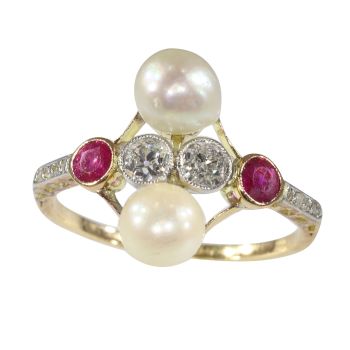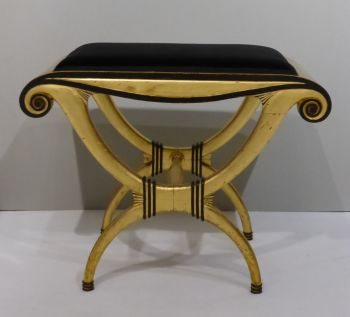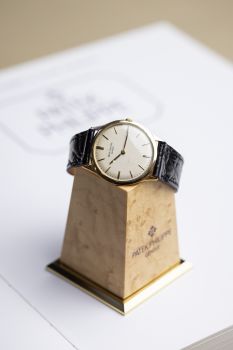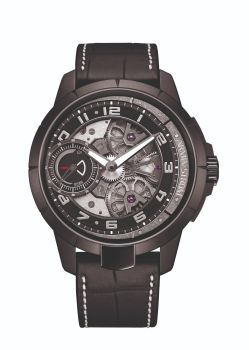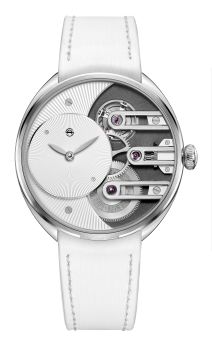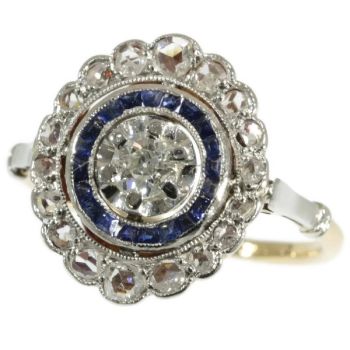Vintage Art Deco platinum ladies wrist watch made by Leon Hatot set with diamonds and sapphires 1920
Leon Hatot
DiamantSaphirEdelsteinPlatin
Derzeit nicht über Gallerease verfügbar
- Über Kunstwerk
Antique jewelry object group
ladies wrist watch
Condition
very good condition
more info on our condition scale
Country of origin
France
Style
Art Deco - Art Deco is an eclectic artistic and design style which had its origins in Paris in the first decades of the 20th century. The style originated in the 1920s and continued to be employed until after World War II. The term "art deco" first sawwide use after an exhibition in 1966, referring to the 1925 Exposition Internationale des Arts Décoratifs et Industriels Modernes that was the culmination of high-end style modern in Paris. Led by the best designers in the decorative arts such asfashion, and interior design, Art Deco affected all areas of design throughout the 1920s and 1930s, including architecture and industrial design, as well as the visual arts such as painting, the graphic arts and film. At the time, this style was seen aselegant, glamorous, functional and modern.
See also: Art Deco
more info on styles
Style specifics
Abstract motives and geometrical forms are quite typical for the Art Deco period. Art Deco moved away from the soft pastels and organic forms of its style predecessor, Art Nouveau, and embraced influences from many different styles and movements of the early 20th century, including Neoclassical, Constructivism, Cubism, Modernism,and Futurism. Its popularity peaked in Europe during the Roaring Twenties and continued strongly in the United States through the 1930s. Although many design movements have political or philosophical roots or intentions, Art Deco was purelydecorative.
Period
ca. 1920
Events & facts of this era, poetry of this era, fashion of this era.
Material
platinum (touchstone tested)
more info on precious metals
Extra information
Leon Hatot (1883-1953) Started in 1911, bought the atelier of Brédillard in Paris and was supplier to the important jewellery houses in quartier Vendôme and of René-Boivin.
Diamonds
Six old brilliant cut with an estimated weight of ± 0.48ct
112 single brilliant cut diamonds (also called 8/8)with an estimated weight of ± 2.00ct
Total diamond count
118 pcs.
Total diamond weight
approx. 2.48 crt with an average colour and clarity F/J, vs/i
All diamond weights, color grades and clarity are approximate since stones are not removed from their mounts to preserve the integrity of the setting.
All diamonds we offer are screened by the I.J.G.C. for whether they are natural or synthetic, and all diamonds in this jewel are 100% guaranteed to be natural.
Precious stones
48 sapphires
It is a very common practice to treat gemstones to intensify their clarity or colour. The item in question has not been tested in this regard.
Birthstones
Diamond is the birthstone (or month stone) for April and sapphire for September.
more info on birthstones
Hallmarks
Mastermark LH for Leon Hatot and the French control mark for platinum representing a dog's head that was in use in France from about 1912.
more info on hallmarks
Dimensions
width case 2,30 cm (0,91 inch)
see picture with a ruler in millimeters and inches
Weight
22,00 gram (14,15 dwt)
- Über Künstler
Léon Hatot (1883 – 1953) war ein leidenschaftlicher Unternehmer: erfinderisch, innovativ und vor allem fortschrittlich. Eigentlich ein Kind seiner Zeit, das von der Anwendung neuester Materialien und Techniken fasziniert war.
Der Unternehmer und Goldschmied Léon Hatot besuchte von 1895 bis 1898 die École d' Horlogerie in Besançon und dann die École des Beaux Arts, ebenfalls in Besançon. In sehr jungen Jahren ließ er sich 1905 als selbstständiger Unternehmer in Besançon nieder und spezialisierte sich auf das Gravieren von Uhrengehäusen.
Bald gründete er auch in Paris eine Werkstatt für Uhrmacher und Juweliere. Hier fertigte er mit Hilfe zahlreicher Handwerker hochwertige Uhren aus besonderen Edelmetallen. Zu dieser Zeit war Hatot eines der wenigen Unternehmen, das sowohl Uhren als auch Schmuck herstellte. Er lieferte sie an die wichtigsten Handelshäuser in der Rue de la Paix in Paris.
Neugierig und zukunftsorientiert interessiert sich Hatot schon bald für die Anwendung von Elektrizität in Uhren. Dies führte 1920 zur Gründung einer Abteilung zur Erforschung und Entwicklung von batteriebetriebenen Zeitmessern. Seit 1923 werden Hatot-Elektrouhren unter dem Markennamen ATO von den Standorten Paris und Besançon aus vertrieben.
Von dem Moment an, als diese Zeitmesser auf den Markt kamen, waren sie ein voller Erfolg. Während der „Exposition international des arts décoratifs“ wurde Hatot für sein gesamtes Programm elektrischer Uhren mit einem „Grand Prix“ ausgezeichnet. Charakteristisch für seine Modelle war, dass sie in Marmor, verchromtem Metall, veredelten Hölzern oder verarbeiteten Vitrinen aus den berühmten Lalique-Manufakturen untergebracht waren.
Aufgrund des dekorativen Designs dieser Zeitmesser ist Hatot in der Lage, sich in der Uhrenwelt einen Namen als „Meister des Art Déco“ zu machen. Sein Beitrag zur wissenschaftlichen Welt ist ebenfalls großartig. Dank seines kreativen und visionären Geistes und seiner zahlreichen Erfindungen gelang es Hatot, die Entwicklungen auf dem Gebiet der Uhren bis einschließlich des zweiten Viertels des zwanzigsten Jahrhunderts auf ein höheres Niveau zu bringen. Frankreich belohnte ihn dafür mit der höchsten nationalen Auszeichnung, der „Légion d'Honneur“.
1931 präsentierte Léon Hatot auf der Kolonialausstellung in Paris eine Reihe kompakter elektrischer Uhren, die den Beginn einer neuen Generation dekorativer Zeitmesser markierten. Er brach komplett mit der gängigen Tradition, in der die Gehäuse als Dekoration dienten und machte den Zeitmesser selbst zum Hingucker. Auf diese Weise wurde Hatot zum Trendsetter für einen neuen modischen Trend.
Artwork details
Related artworks
Unbekannter Künstler
Frühe Art-Deco-Brosche1920
Preis auf AnfrageAns Hemke-Kuilboer Juwelier & Antiquair
1 - 4 / 24Armin Strom
Armin Strom "Lady Beat Rosé Gold Mother of Pearl"2022 - 2023
Preis auf AnfrageHa-Juweliers
Armin Strom
Armin Strom Lady Beat "Manufacture Edition White"2022 - 2023
Preis auf AnfrageHa-Juweliers
Armin Strom
Armin Strom "Mirrored Force Resonance First Edition"2022 - 2023
Preis auf AnfrageHa-Juweliers
1 - 4 / 24- 1 - 4 / 24








